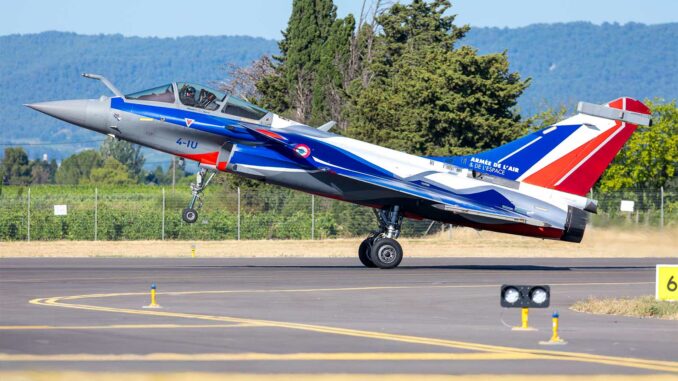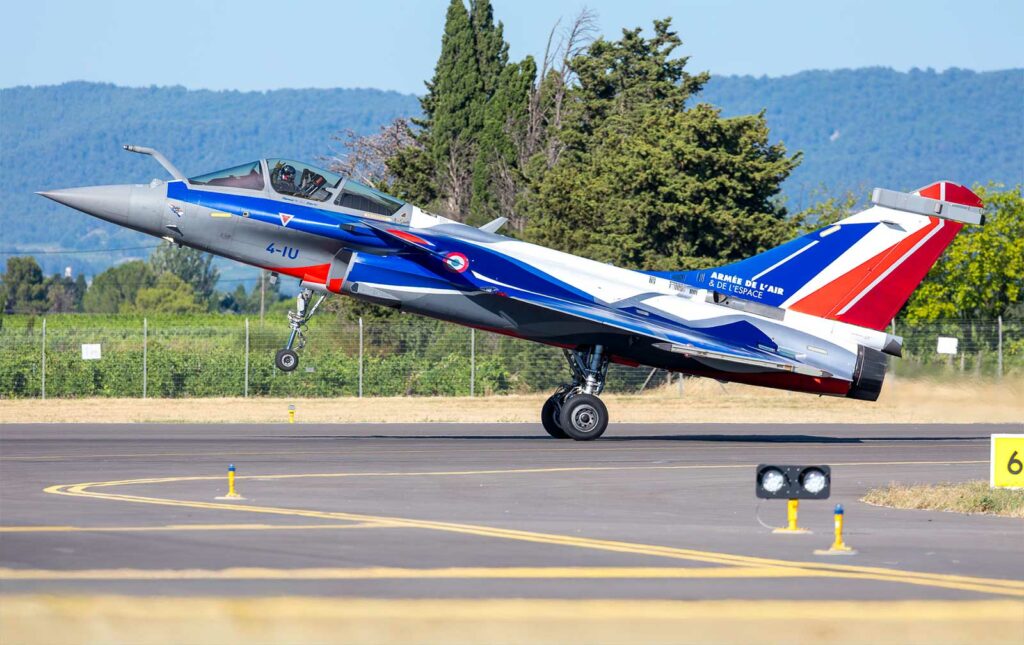
The 2026 finance bill provides for the purchase of 60 additional Rafale jets, strengthening the French fleet and supporting the national defense industry.
Summary
The French government has confirmed, as part of the 2026 finance bill, the order for 60 new Rafale fighter jets produced by Dassault Aviation. These aircraft, based on the F4 and F5 standards, will bring the French fleet to 285 units by the end of the decade. This major acquisition consolidates national air sovereignty in an unstable international context, while sparing civilian budgets. The investment also supports the French defense industrial and technological base (BITD), with more than 14,000 direct jobs at Dassault Aviation and several thousand indirect jobs in the aeronautics sector. This strategic choice aims to guarantee the continuity of operational capabilities, prepare for the transition to the Future Air Combat System (SCAF), and preserve France’s strategic autonomy within European defense.
The 2026 finance bill is part of strategic continuity
Priority given to national defense
The 2026 finance bill reflects a clear direction: to maintain a sustained defense effort in the face of an unstable geopolitical environment. The acquisition of 60 new Rafale aircraft is estimated at around €7.5 billion, financed without cutting civilian budgets, particularly those for education and health. This decision illustrates the government’s desire to maintain a capacity for deterrence and autonomous action, in line with the 2024-2030 Military Programming Law, which provides for a total budget of €413 billion for the armed forces.
This additional order is part of a strategy to gradually modernize the French combat fleet, as some Mirage 2000-5 and Mirage 2000D aircraft are approaching the end of their operational life. It also guarantees the stability of the industrial workload for Dassault Aviation, Thales, Safran, and MBDA, key partners in the Rafale program.
A fleet increased to 285 aircraft
With these 60 additional units, France will bring the total number of Rafales delivered or on order to 285 aircraft, all versions combined. This increase in capacity is intended to compensate for export deliveries (Egypt, India, Croatia, Indonesia) which had temporarily reduced the number of aircraft available to the French forces.
The Air and Space Force should eventually have around 220 Rafales, while the French Navy will operate 65 on the future PA-NG aircraft carrier. This format will enable France to maintain a high level of alert, with the potential for rapid deployment to several theaters of operations simultaneously.
The Rafale F4/F5: the backbone of French air power
Developments in the F4 standard
The Rafale F4, the first deliveries of which began in 2024, incorporates significantly enhanced capabilities. It benefits from a secure communication system, expanded connectivity (tactical and satellite data links), predictive maintenance, and new onboard artificial intelligence functions. The RBE2 AESA radar, the SPECTRA electronic warfare system, and the EMTI/MDPU central computer have been upgraded to better handle data fusion and networked mission management.
Operationally, the F4 is capable of employing new generations of weapons, including the Meteor air-to-air missile, the AASM 1000 kg, and the Talios and Reco NG pods. It enhances collaborative combat capabilities, which are essential in high-intensity scenarios where information superiority determines the outcome of engagements.
The future F5 standard: a transition to SCAF
Development of the Rafale F5 is already underway, with deliveries scheduled for 2030-2032. This standard will incorporate a more open architecture, facilitating the integration of accompanying drones, Remote Carriers, and new tactical data processing algorithms. It is also designed to interact with the future Franco-German-Spanish Future Air Combat System (SCAF).
The investment in 60 new aircraft will provide France with a consistent technological base, ensuring a smooth transition between generations. The Rafale will remain the backbone of France’s strategic and conventional air forces for at least two decades.

Industrial and economic impact: a major boost for Dassault Aviation
Consolidation of the French aerospace industry
For Dassault Aviation, this new order represents a strong signal and a secure production horizon until the end of the 2030s. The company, which employs more than 14,000 people in France, depends largely on the Rafale program, which currently has a production rate of 3 to 4 aircraft per month. This order will enable the company to maintain this activity in the long term, while consolidating the expertise of its sites in Mérignac, Argonay, Biarritz, Martignas, and Saint-Cloud.
Around Dassault, the supply chain mobilizes more than 500 French subcontractors, including Thales (radar and avionics), Safran Aircraft Engines (M88 engine), and MBDA (weapons). In total, the Rafale sector supports around 28,000 direct and indirect jobs. The multiplier effect on the regions is significant: every euro invested in the program generates more than one euro in economic and tax revenue in return.
An influence on exports and sovereignty
This domestic order also strengthens the Rafale’s credibility for export. By demonstrating sustained internal confidence, France is sending a signal to foreign buyers about the program’s sustainability and the continuity of industrial support. Since 2015, the Rafale has established itself in several markets (Egypt, India, Greece, Croatia, and Indonesia), totaling more than 570 orders to date.
The government’s strategy aims to preserve French industrial sovereignty in the face of American and European competition, while ensuring strategic autonomy for critical components. This approach avoids any dependence on imports of sensitive equipment and ensures complete control of the technological chain.
The geopolitical context: France in search of operational superiority
A changing security environment
The announcement comes at a time of global tension. Conflicts in Ukraine and the Middle East, rising tensions in the South China Sea, and hybrid threats in Europe underscore the need for a rapid and credible response capability. As a nuclear power and permanent member of the UN Security Council, France must have a comprehensive and responsive air defense capability.
The target format of 285 Rafale aircraft will enable a sustained engagement rate: defense of metropolitan France, airborne nuclear deterrence, overseas missions, and participation in international coalitions. Fighter aircraft remain at the heart of the French military model, capable of projecting power at over 3,700 km/h (Mach 1.8) and with a range of over 3,700 km with refueling.
Enhanced integration within European defense
Beyond national sovereignty, France is part of a more structured European defense cooperation. The Rafale, present in several EU countries, is becoming a vehicle for interoperability and tactical convergence. The gradual alignment of communication systems, weapons, and operational procedures facilitates joint deployments and coordinated missions within the framework of NATO or ad hoc coalitions.
This strategy consolidates the Rafale’s position as a European standard, capable of competing with the American F-35 while remaining under French technological control.
A sustainable strategic dynamic
The purchase of 60 new Rafale F4/F5s is a major step in the modernization of the French air force. It guarantees the continuity of strike capabilities, industrial sovereignty, and job stability in the aerospace industry. Beyond the figures, it confirms the coherence of the French model: a balance between operational power, technological independence, and economic contribution.
The Rafale remains the symbol of a France capable of innovating, producing and deciding on its own. At a time when threats are diversifying, this decision illustrates the conviction that air superiority remains one of the pillars of national sovereignty and the country’s strategic credibility.
Sources
Ministry of the Armed Forces – 2026 Finance Bill, Defense section.
Dassault Aviation – Press release on the Rafale national order.
Thales Group – Rafale F4 technical data sheet.
Safran Aircraft Engines – M88 engine file and F5 prospects.
National Assembly – 2024-2030 Military Programming Law, implementation report.
War Wings Daily is an independant magazine.